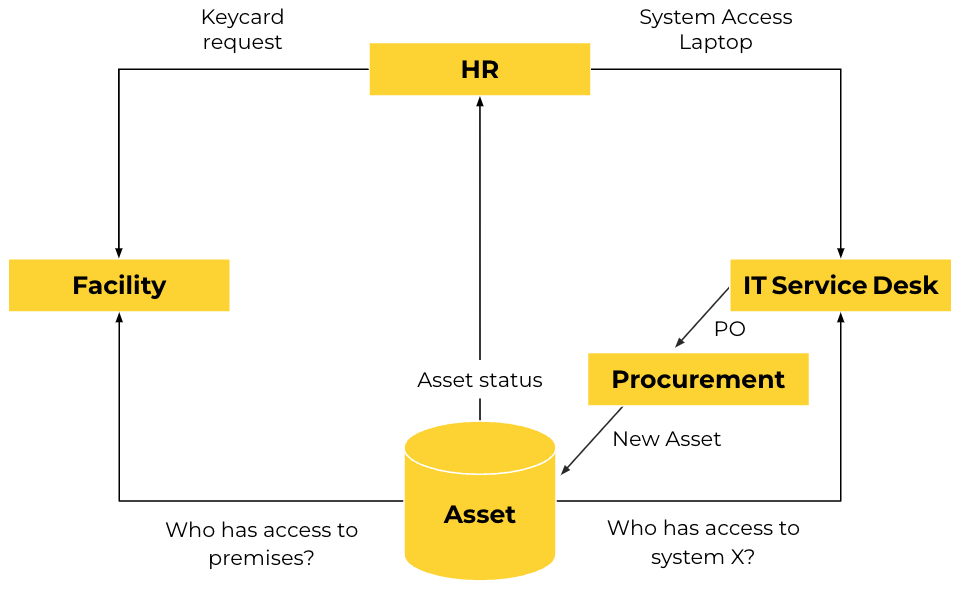Creating a lasting impression with ITSM tools

Your new marketing hire (we’ll call her Sarah) has arrived for her first day of work on time and excited to get stuck in, but instead of diving into her responsibilities as she imagined on her drive to the office, she's bogged down by a flurry of emails, phone calls, and visits to different departments just to get basic needs met, like a key card, system access, laptop, etc.
This is not a good first impression. You might be thinking, “Hang on a minute, the new employee should be impressing me, not the other way around!” However, making a good first impression as an employer is crucial in today’s modern era.
Gone are the days of businesses acting as if they’re doing employees a favor by hiring them. Today’s generation cares more about company culture. They actively seek workplaces that align with their personal values and prioritize work-life balance. They want opportunities for growth and development and a sense of belonging and purpose in their careers.
Making a good first impression
Making a good first impression on new hires boosts retention, engagement, and performance and enhances your reputation as an employer. It reduces recruitment costs and ensures a better cultural fit, ultimately leading to a positive employee experience, which translates into business success over time.
Traditional onboarding and offboarding processes are clunky, time-consuming, and error-prone, leaving new hires frustrated and managers overwhelmed. Modern solutions that are transforming these experiences include ticketing technology, which comes under the ITSM umbrella.
Think of a ticketing system as a central place to track service requests. Instead of manual emails, phone calls, or lost messages, employees (including managers) can submit requests through a simple interface, specifying their needs. This eliminates chaos and ensures everyone's on the same page.
Now, let’s look at some more benefits of this technology.
Seamless onboarding with ITSM tools
If you had a service management application at your disposal, you could log onto a user-friendly portal as soon as Sarah signed the contract and easily request work items she needs to fulfill her role.
Less time hunting for email addresses and worrying about ordering the right items means more time making her feel welcome. She can get stuck in sooner rather than later without having to wait for whatever she needs to arrive. Not only does it save time, but it reduces stress and sets the stage for a positive first impression.
Clear visibility through the ticketing system means both you and Sarah can see updates on request statuses in real-time, identify any roadblocks early on, and proactively address them instead of spending hours chasing approvals.
Effortless offboarding
Fast forward a few years, and Sarah has decided to move on. It's nothing against you; she's just ready to take on a different challenge in a new environment.
Using the same ticketing technology you used to onboard her, you can just as easily initiate offboarding. With automated workflows triggered by her departure notification, the system can initiate the return of her laptop, phone, and any other assets, which means no more chasing down equipment or worrying about lost items.
You can also capture Sarah's valuable feedback through integrated exit interviews within the ticketing system, which helps identify areas for improvement to refine your onboarding experience for future hires.
One platform that does it all
Nobody has time to juggle different systems, lose track of requests, or continuously switch between interfaces. In this day and age, you should and can manage all service requests across departments—IT, facilities, procurement, HR, etc., in one central platform, and yet not every business knows this is possible.
Tools like Jira Service Management can help teams gain insights into request trends and identify areas for improvement through reporting and analytics. This data-driven approach helps you optimize your processes and allocate resources effectively.
By empowering employees with a self-service portal, you’ll be able to benefit from faster resolution times and transparent communication. A well-functioning ticketing system fosters a culture of efficiency and empowers employees to get things done quickly and easily, which will improve the employee experience for a lasting positive impression beyond onboarding.

The diagram above shows how HR interacts with departments via requests to onboard new hires.
Self-assess before taking action
Before you jump the gun and adopt any old ticketing system, it's crucial to assess your current situation.
The ITIL4 guiding principles offer a valuable framework for self-assessment:
Focus on value: Consider the pain points of your current onboarding and offboarding processes. Where are inefficiencies costing time and resources? Where are frustrations impacting employee experience?
Start where you are: Don't aim for a complete overhaul overnight. Identify quick wins where automation can offer immediate improvement. Consider high-volume, repetitive tasks like key card requests or laptop provisioning.
Collaborate and promote visibility: Involve stakeholders across departments (HR, IT, facilities, etc.) in the assessment and implementation phase. Foster open communication and transparency to ensure everyone understands the benefits and goals.
Progress iteratively with feedback: Remember, this is a journey, not a destination. Implement your ticketing system iteratively, gather feedback, and use data-driven insights to continuously refine your processes.
Craft your roadmap and implementation strategy
Developing a clear roadmap ensures a smooth transition to your new system. Here are some key steps that will help you build a roadmap and implementation strategy for a successful transition to a ticketing system, ensuring a smooth journey for everyone involved.
- Identify the pain points you want to tackle, be it slow onboarding, cumbersome approvals, or scattered service requests lying in different functional inboxes. Set achievable goals and desired outcomes to guide your implementation.
- Gather key stakeholders and secure their buy-in by highlighting the benefits and addressing concerns.
- Select a ticketing system that fits your needs, budget, and scalability. Consider cloud-based solutions for ease of deployment and maintenance.
- Consider a pilot launch to iron out initial kinks. Monitor key metrics like resolution times and employee satisfaction levels. Gather feedback continuously and use it to optimize your processes.
Additional considerations
To ensure a smooth launch and ongoing success, remember to start small and scale gradually by defining a focused scope, setting realistic timelines, and managing expectations with transparency.
Remember, choosing the right ticketing system is crucial. Popular apps like Jira Service Management, Jira Work Management, ServiceNow, Freshworks, and Zendesk offer robust features and scalability. Consider factors like ease of use, integrations, and cost when making your decision.
The focus should be on empowering new hires and seasoned employees alike because that’s ultimately what you want new hires to become! By selecting the right ticketing system for your needs and following the advice in this blog post, you will transform your operations beyond onboarding and offboarding, creating a smoother, more efficient, and positive experience for everyone.
Published:
Updated:


